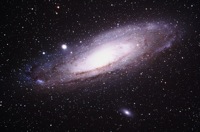Difference between revisions of "Andromeda"
(Created page with 'File:lighterstill.jpgright|frame The '''Andromeda''' Galaxy is a spiral galaxy approximately 2,500,000 light-years (1.58×1011 AU) away[4] in...') |
m (Text replacement - "http://" to "https://") |
||
| Line 1: | Line 1: | ||
[[File:lighterstill.jpg]][[File:M31_Lanoue.jpg|right|frame]] | [[File:lighterstill.jpg]][[File:M31_Lanoue.jpg|right|frame]] | ||
| − | The '''Andromeda''' Galaxy is a [[spiral galaxy]] approximately 2,500,000 [[light-years]] (1.58×1011 AU) away[4] in the constellation Andromeda. It is also known as [ | + | The '''Andromeda''' Galaxy is a [[spiral galaxy]] approximately 2,500,000 [[light-years]] (1.58×1011 AU) away[4] in the constellation Andromeda. It is also known as [https://en.wikipedia.org/wiki/Messier_object Messier] 31, M31, or NGC 224, and is often referred to as the Great Andromeda [[Nebula]] in older [[texts]]. Andromeda is the nearest spiral galaxy to our own, the [[Milky Way]]. As it is visible as a faint smudge on a moonless night, it is one of the farthest objects visible to the naked eye, and can be seen even from urban areas with binoculars. It is named after the princess [https://en.wikipedia.org/wiki/Andromeda_(mythology) Andromeda] (Greek: Ανδρομέδη – Andromédē) in [[Greek]] [[mythology]]. |
| − | Andromeda is the largest galaxy of the [ | + | Andromeda is the largest galaxy of the [https://en.wikipedia.org/wiki/Local_Group Local Group], which consists of the Andromeda Galaxy, the [[Milky Way]] Galaxy, the [https://en.wikipedia.org/wiki/Triangulum_Galaxy Triangulum Galaxy], and about 30 other smaller galaxies. Although the largest, Andromeda may not be the most massive, as recent findings suggest that the Milky Way contains more [[dark matter]] and may be the most massive in the grouping. The 2006 observations by the [https://en.wikipedia.org/wiki/Spitzer_Space_Telescope Spitzer Space Telescope] revealed that M31 contains one trillion [[stars]], several times more than the number of stars in our own galaxy, which is estimated to be c. 200-400 billion. While the 2006 estimates put the [[mass]] of the Milky Way to be ~80% of the mass of Andromeda, which is estimated to be 7.1 × 1011 [https://en.wikipedia.org/wiki/Solar_mass solar masses], a 2009 study concluded that Andromeda and the Milky Way are about equal in mass. |
| − | At an [ | + | At an [https://en.wikipedia.org/wiki/Apparent_magnitude apparent magnitude] of 3.4, the Andromeda Galaxy is notable for being one of the brightest [https://en.wikipedia.org/wiki/Messier_object Messier objects], making it easily visible to the naked eye even when viewed from areas with moderate [https://en.wikipedia.org/wiki/Light_pollution light pollution]. Although it appears more than six times as wide as the full [[moon]] when photographed through a larger telescope, only the brighter central region is visible with the naked eye.[https://en.wikipedia.org/wiki/Andromeda_Galaxy] |
[[Category: Astronomy]] | [[Category: Astronomy]] | ||
Latest revision as of 23:43, 12 December 2020
The Andromeda Galaxy is a spiral galaxy approximately 2,500,000 light-years (1.58×1011 AU) away[4] in the constellation Andromeda. It is also known as Messier 31, M31, or NGC 224, and is often referred to as the Great Andromeda Nebula in older texts. Andromeda is the nearest spiral galaxy to our own, the Milky Way. As it is visible as a faint smudge on a moonless night, it is one of the farthest objects visible to the naked eye, and can be seen even from urban areas with binoculars. It is named after the princess Andromeda (Greek: Ανδρομέδη – Andromédē) in Greek mythology.
Andromeda is the largest galaxy of the Local Group, which consists of the Andromeda Galaxy, the Milky Way Galaxy, the Triangulum Galaxy, and about 30 other smaller galaxies. Although the largest, Andromeda may not be the most massive, as recent findings suggest that the Milky Way contains more dark matter and may be the most massive in the grouping. The 2006 observations by the Spitzer Space Telescope revealed that M31 contains one trillion stars, several times more than the number of stars in our own galaxy, which is estimated to be c. 200-400 billion. While the 2006 estimates put the mass of the Milky Way to be ~80% of the mass of Andromeda, which is estimated to be 7.1 × 1011 solar masses, a 2009 study concluded that Andromeda and the Milky Way are about equal in mass.
At an apparent magnitude of 3.4, the Andromeda Galaxy is notable for being one of the brightest Messier objects, making it easily visible to the naked eye even when viewed from areas with moderate light pollution. Although it appears more than six times as wide as the full moon when photographed through a larger telescope, only the brighter central region is visible with the naked eye.[1]
